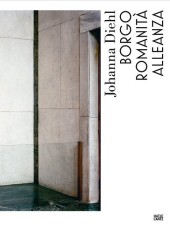 Neuerscheinungen 2014Stand: 2020-02-01 |
Schnellsuche
ISBN/Stichwort/Autor
|
Herderstraße 10
10625 Berlin
Tel.: 030 315 714 16
Fax 030 315 714 14
info@buchspektrum.de |

Johanna Diehl, Falk Haberkorn, Christin Müller, Miriam Paeslack
(Beteiligte)
Johanna Diehl
Borgo Romanità Alleanza. Ausgezeichnet mit dem Deutschen Fotobuchpreis in Silber 2015
Text: Haberkorn, Falk; Müller, Christin; Paeslack, Miriam
2014. 160 S. 71 Abb. 320.0 mm
Verlag/Jahr: HATJE CANTZ VERLAG 2014
ISBN: 3-7757-3879-7 (3775738797)
Neue ISBN: 978-3-7757-3879-8 (9783775738798)
Preis und Lieferzeit: Bitte klicken
Johanna Diehls ungewöhnliche Fotoserien widmen sich der kalten Ästhetik steingewordener Propaganda
Potemkinsche Dörfer zwischen Pinien: In ganz Italien wurden unter Mussolinis Diktatur sogenannte Borghi gebaut, am Reißbrett geplante Mustersiedlungen im Sinne der proklamierten faschistischen Agrarreform. Besonders in Sizilien stehen sie nach wie vor leer, sind Kulissendörfer geblieben. Johanna Diehl (geb. 1977) dokumentiert in ihrer puristisch-strengen Serie Borgo mit der Plattenkamera über 20 dieser utopischen Plansiedlungen und zeigt sie als geisterhafte Theaterszenerien mitsamt Parteigebäuden und Triumphbögen. In der Folge Romanità untersucht die Fotografin Materialien und Bildprogramme öffentlicher Gebäude Roms aus dieser Zeit: Marmor und martialische Fresken schlagen historische Bögen vom alten Rom bis zum Faschismus und bestimmen bis heute die Atmosphäre in Ministerien und im Kongresszentrum der Stadt. In Alleanza findet Diehl architektonische Belege für eine unheilige Allianz zwischen Kirche und Staat in den Jahren der Diktatur, wie sie in der Formensprache damaliger pathetischer Kirchenbauten Ausdruck fand.
Under Mussolini planned model settlements called borghi were constructed throughout Italy to implement fascist agrarian reforms. Particularly in Sicily many of these structures still stand empty. In her visually pared-down series Borgo, Johanna Diehl ( 1977) uses a large-format camera to document over twenty of these utopian settlements, portraying them as ghostly theater sets, with buildings designated for party gatherings and triumphal arches. In her subsequent series Romanità she examines the materials and imagery of public buildings in Rome from this period. Marble and martially intoned frescos illustrate the fascist historical lineage as dating back to ancient Romean aesthetic still dominating the atmosphere of ministries and congress halls in the capital. In Alleanza the photographer finds architectural records of the unholy alliance between church and state in the years of the dictatorship, as expressed in the lofty, formal language of churches constructed at this time.


